Acting on Your Opportunity Identification (OppID) Insights: Campaign Ideas for Marketers
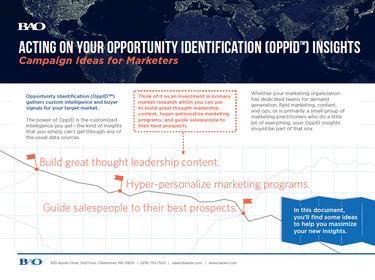
The power of Opportunity Identification (OppID) is the customized intelligence you get—the kind of insights that you simply can’t get through any of the usual data sources.
Think of it as an investment in primary market research which you can use to build great thought leadership content, hyper personalize marketing programs, and guide salespeople to their best prospects.
Whether your marketing organization has dedicated teams for demand generation, field marketing, content, and ops, or is primarily a small group of marketing practitioners who do a little bit of everything, your OppID insights should be part of that mix.
Throughout this guide, we’ll use a real-world example from an actual OppID study conducted into Fortune 2000 organizations to understand Big Data installations, challenges and initiatives.
Among the many benefits of an OppID project is that every account is segmented, using the information from the profile survey, into one of four (or more) categories based on the criteria you specify. In this example, the segmentation and segment criteria included:
BULLSEYE:
- >500 TB of data
- And is using Microsoft Azure or AWS for cloud
- And has an active initiative for a new or overhaul Big Data solution or Hadoop implementation
BIG DATA/DATA WAREHOUSING BUYERS:
- >500 TB of data
- And is using Microsoft Azure or AWS for cloud
- And has one or more active initiatives to implement other Big Data or Data Warehousing solutions within the next 6-12 months and the vendor is not yet selected
BIG DATA PLATFORM CHALLENGES:
- >500 TB of data
- And is using Microsoft Azure or AWS for cloud
- And rated current Big Data platform a “C” (A-F scale) or lower and identified one or more challenges with current Big Data solution
NURTURE:
- >100 TB of data
- And is using Microsoft Azure or AWS for cloud
- And has no active initiatives and is satisfied with their current Big Data solution
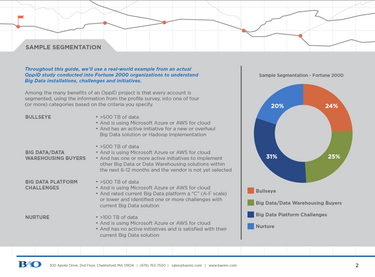
Integrating your OppID insights into your email marketing can make a big difference with minimal effort.
When your emails refer to pain points or needs that are specific to that individual and his/her initiative, your message is more likely to resonate and elicit an action.
The key to integrating OppID insights into your email marketing is your segments. For the example provided above, segments include Bullseye, Big Data/Data Warehousing Buyers, Big Data platform challenges and Nurture. Companies in each unique segment should be put into a different email track that aligns with segment criteria for each.
For example:
Below is a sample OppID profile for Globalco with detail question and answers.
| Company: Globalco | |
| Segment: Big Data/Data Warehousing Buyer | |
| 1. Does your organization use (or plan to use) Hadoop for Big Data? | Yes |
| 2. Which platform do you currently use for your cloud deployment? | AWS |
| 3. How is your organization currently using Big Data solutions and/or management? |
|
| 4. How long has your organization had big data management in place? | > 3 years |
| 5. Which Big Data Platform(s) do you currently have in place? |
|
| 6. How do you grade your current Big Data Platform? |
|
| 7. What types of challenges do you regularly experience with your Big Data platform? |
|
| 8. How large is your organization’s Data Warehousing environment? | 751TB - 1PB |
| 9. What percent of your data is unstructured data? | > 50% |
| 10. What databases and technologies are currently running in your organization’s IT environment? | Database A Database B |
| 11. What types of general data challenges do you regularly experience? |
|
| 12. Which of the following initiatives does your organization have budgeted? Where are you in the implementation/decision making process? | Data warehouse optimization (Discovery /planning) |
| 13. When do you plan to finalize your decision and begin implementation? | 6-12 months |
Below we describe two ways to up-level your emails—through subject lines and body copy.
Perhaps the most impactful and visible place to reach prospects with greater personalization is by refining and tailoring your subject lines based on the insights from the OppID profiles.
Including a revealing tidbit related to their upcoming initiatives, current challenges, or installed solutions is sure to grab their attention. It also communicates that your organization has done its homework and that you’re serious about offering them relevant solutions.

Information in [[brackets]] denotes answers/ data provided through OppID:
As you integrate your OppID insights into your marketing campaigns, you’ll want to be sure to upload the contacts provided in the OppID deliverable – these are fresh, live-validated contacts with emails and many direct dial phone numbers. For those accounts in your most qualified segments, spend the time adding additional contacts in those accounts since you know they are priority prospects for you.
Body Copy
You can take personalization one step further by similarly integrating the OppID insights into the body of emails, crafting copy that intelligently addresses the prospect’s unique environment. The more specific and relevant you can get in your email, the more likely it is to convert.
Grab attention with a unique stat:
Tell prospects something they didn’t already know by pulling out a bold stat from the OppID results. In our Big Data example, 25% of companies said that their biggest challenge was analyzing unstructured data—an interesting data point that most prospects can probably relate to.
A subject line or statement like “25% of orgs told us unstructured data is their top big data challenge,” paired with a useful solution feature or interesting offer around analyzing unstructured data would go a long way to providing value.
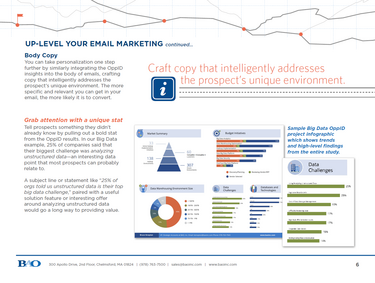
Among the most unique perspectives you can bring to your prospects is insights into their peers’ challenges and experiences. While the individual account insights are incredibly beneficial to your team, the rolled up insights from your entire study are invaluable to your target audience. You can break through the thought leadership “noise” in your marketplace but providing truly practical and exclusive content that your prospects can learn from.
Over the years, many clients have built “Current state of…” reports, e-books, infographics, and other types of content based on industry trends, market stats, and real-world challenges uncovered in their OppID studies. They’ve reported great results in promoting these trend reports via email marketing, as well as on social media.
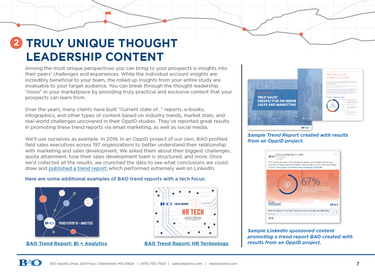
We’ll use ourselves as example. In 2019, in an OppID project of our own, BAO profiled field sales executives across 197 organizations to better understand their relationship with marketing and sales development. We asked them about their biggest challenges, quota attainment, how their sales development team is structured, and more. Once we’d collected all the results, we crunched the data to see what conclusions we could draw and published a trend report, which performed extremely well on LinkedIn.
Here are some examples of BAO trend reports:
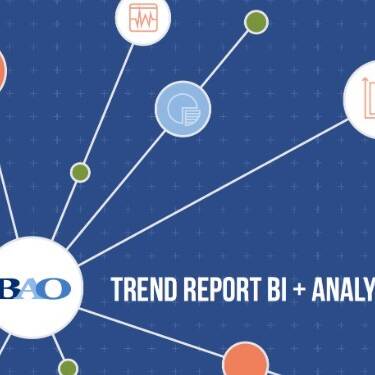


Your OppID insights provide you with the most accurate and influential competitive intelligence available. Unlike online tools - this is insight into the companies you selected, with exactly the prescriptive data that matters to your business, including exposed weaknesses and contract expiration dates.
Once you know which accounts are using which competitive solutions, you can develop targeted take-out programs. By creating different programs based on the competitor installed (and the identified weaknesses within those accounts), you can focus on the specific differentiators where you’ve got them beat. If you’re already running displacement campaigns targeting users of a particular competitor, the accounts that have been profiled through the OppID naturally plug right into this process.
Having these valuable account insights at your disposal is a great opportunity to collaborate with sales, offering this insight to improve sales’ battle cards and pitches, and also with product marketing, to give that timely prospect feedback.
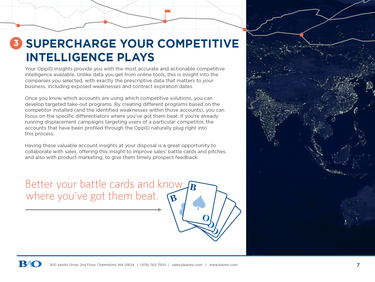
In addition to the marketing campaigns and use cases presented in this document, the other main benefit of OppID is the ability to guide salespeople to their best prospects. OppID provides extensive value to your entire sales organization by:
The account specifics obtained through the OppID process are unavailable to anyone else, so your sales organization can leverage them to have truly differentiated sales conversations that turn into pipeline.
For more, check out Using Your OppID Insights to Maximize Pipeline, which provides tips and best practices for sales development.
This is just the tip of the iceberg. Whatever your marketing objectives are, OppID insights can help you improve awareness and generate more leads. Contact us if you’d like to explore a different use case for your OppID insights—we’re happy to help in any way we can.
